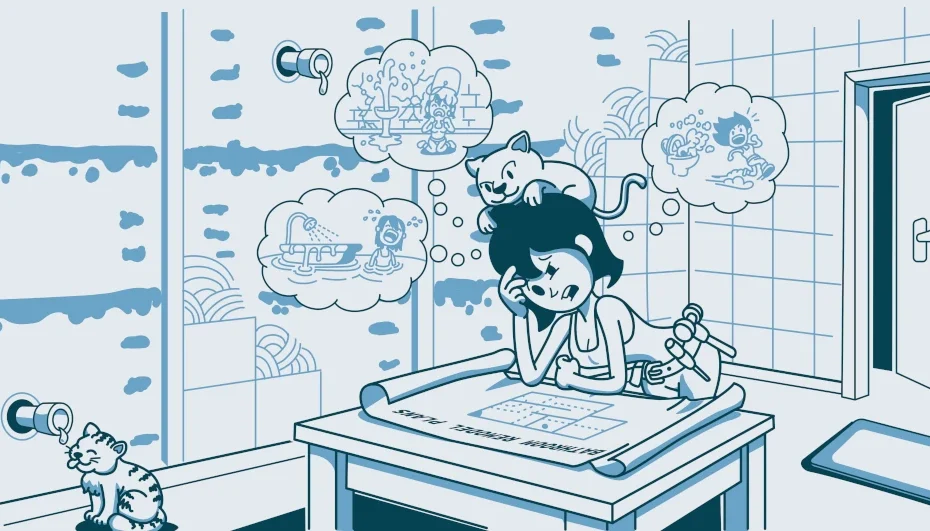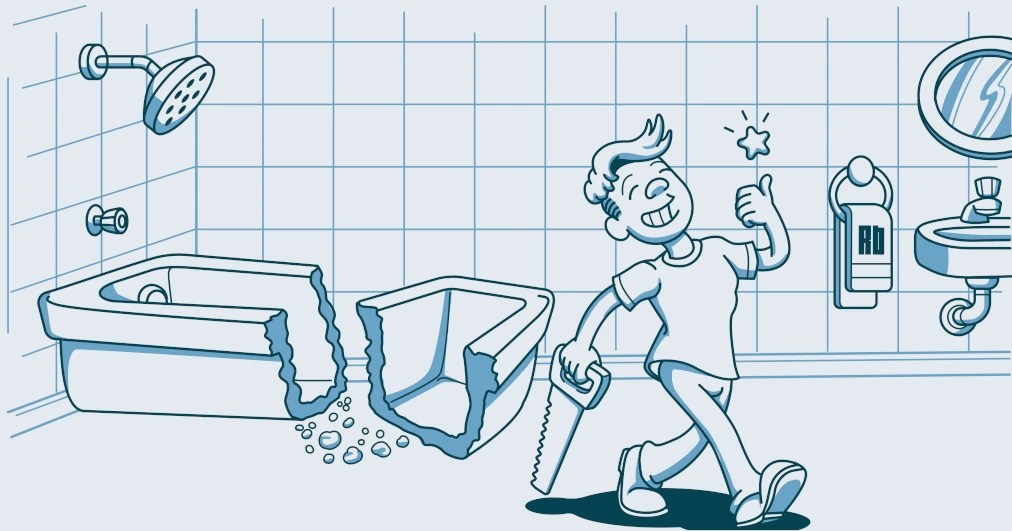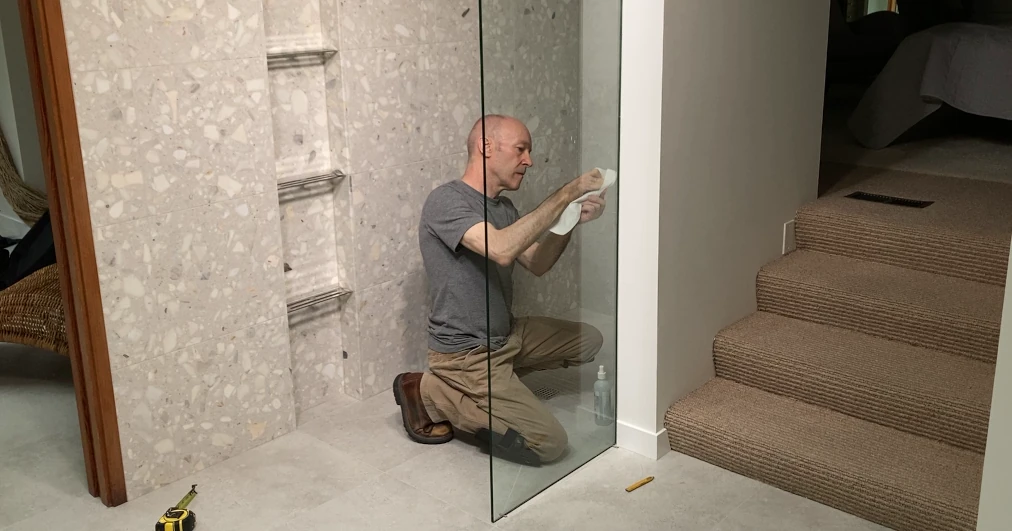Starting a bathroom remodeling project can be exciting but can also be overwhelming without a good plan. So, I decided to write this post to help you navigate this process. I’m Steve Gehrmann, with Redblock Industries (Steve’s Bio). I’ve been remodelling bathrooms for 15 years, so I have a bit of experience with this stuff, needless to say. I’ll go over the most important things you need to do to prepare for a complete bathroom remodel. Whether you’re planning a full or partial remodel, I think this post will provide you with all that you need to prepare for this often-intimidating process.
Highlights
- Define the scope of your project carefully.
- Deciding to DIY, managing the project yourself, or to hire a contractor
- Assessing your Bathroom Layout and determining your priorities.
- Establish a realistic budget that covers materials, labor, and unexpected expenses.
- Preparing for your remodel – A step-by-step approach
- FAQ
Determining the Project Scope – A Checklist
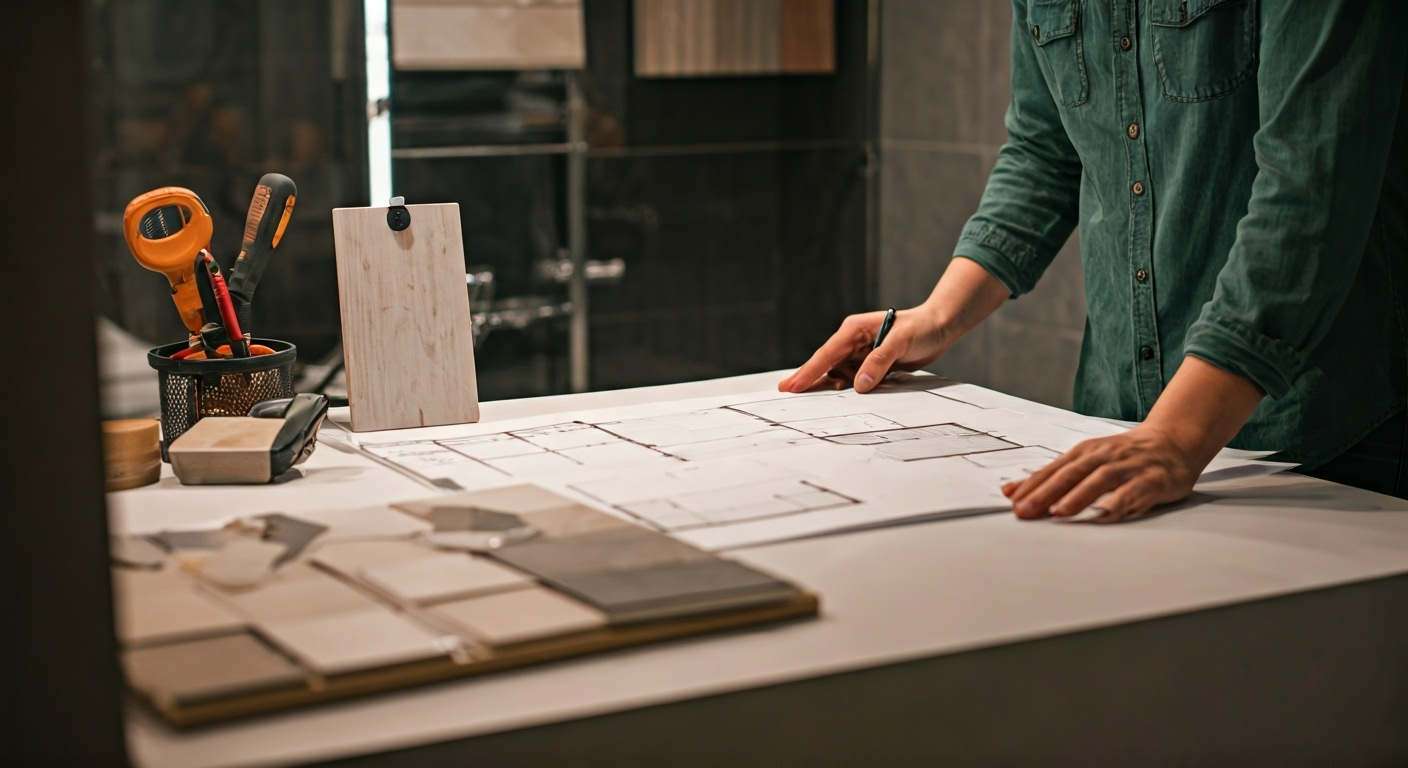 The scope of your project simply means how much of your bathroom you’re planning to remodel. This decision obviously will a have a lot to do with your budget, or whether you’re planning to do all or part of the work yourself, but I will talk about these items in the sections to follow.
The scope of your project simply means how much of your bathroom you’re planning to remodel. This decision obviously will a have a lot to do with your budget, or whether you’re planning to do all or part of the work yourself, but I will talk about these items in the sections to follow.
I always stress that my clients write up a bathroom remodel checklist to determine some realistic priorities. So many of them dream about all the cool new fixtures and features in their new bathroom before they do this assessment. Then after that project starts, they realize that their plans are larger than their budget, and they become disappointed and discouraged.
Another important consideration is the square area of your bathroom and what fixtures will fit in the space; if there’s enough room for one (or two) people to move around freely in the space, and the ergonomics of the space, especially the shower. You don’t want to feel like the space is too crowded, especially after spending all that money. I will go over this in more in a dedicated section to follow.
I always suggest to my clients that a designer be hired to come up with an overall design, and layout. This is really helpful for whole bath remodels, especially if fixtures are going to be moved. Moving fixtures can easily destroy your budget if unanticipated structural or plumbing upgrades are required (very common). And since the look and feel of your new bathroom is so important to your enjoyment of the space, you don’t want to neglect this part, especially if you’re not confident with layout and design.
DIY, Project Management or Hiring a Contractor
The decision to DIY, manage the project yourself, or to hire a contractor for the whole project, depends a lot on your skill level, project complexity, and your confidence & motivation.
If you decide to diy, you’d better be sure you want to take this on, because without total commitment you’ll probably regret it.
Are you want to project manage your own bathroom renovation? Managing the project yourself can also be deceptively complex and problematic. In my experience as a contractor, this is a bad idea for every homeowner, regardless of their remodel experience. Homeowners tend to rely on the expertise of the trades to guide their part of the project that each particular trade is “responsible” for. This is a huge mistake because trades don’t work that way. They will only do what you tell them to do, and they won’t likely take responsibility for any part of the job. That is the contractor’s responsibility, and you’re not paying them for that.
A Diy project can be very compelling because bath reno projects are expensive, so finding ways to save money may become your highest priority. Try not to fall into this trap because mistakes will be made if you try to take on too much.
Hiring a contractor greatly increases the chances of professional quality and adherence to local building codes, but it’s also no guarantee. As you probably know, all bathroom remodel contractors are not created equal, so it’s in your interest to be very careful when hiring one.
Whatever portion of the job that you decide to hire out, make sure that you thoroughly investigate the contractor’s reputation. Good Google reviews are important, but I would seriously recommend that you speak with a couple of their past clients to get a more complete understanding of how smoothly their past projects went.
If you really want to take on a “do it yourself” project, and you’re interested in building your own custom walk in shower (curbless shower / barrier free shower), I’d suggest that you check out my DIY Walk in Shower post. Here I will provide you with all you need to know to build your own curbless shower, step by step.
Bathroom Layout and Remodeling Priorities
If you decide not to hire an interior designer to do this, you should spend a lot of time on your new bathroom’s floor plan.
To determine a realistic new layout, look at the existing fixtures in the room. Think about what you like about the current space and fixtures, and what you don’t like. Ask yourself, is the old layout makes the room feel big enough, or is there too little room for the current fixtures?
Think about if moving things like the tub or sink would help with the layout or make it work better for you. Ask yourself how extensive will your renovation need to be?
Do you just need a new vanity and lav faucet, or to fix some long standing issues with your shower, or improving your shower storage? If so, a full bathroom remodel may not be necessary.
I would suggest you spend a lot of time on determining exactly what your wants and needs are, so you don’t end up spending all your money on an entirely new bathroom when all you really needed was an upgrade.
A Realistic Plan
When planning a bathroom remodel, determining the goals of the project is key. Do you want your bathroom to have more functionality, more luxury, or a bit of both?
Practicality
I always suggest to my clients to first think about the things they do in the bathroom every day, and if any of their experiences frustrate them at all. Has the shower always felt too small? Is the vanity bench top too small for your needs? Is it a hassle to store all your towels, robes and bath supplies efficiently? If so, maybe adding some extra storage or increasing the shower footprint would be the best use of the space.
When planning a bathroom remodel, you must also consider the full purpose of the room. Will it be for you and your spouse only, or will family or guests need to use it as well? After you determine the purpose of the space, you can then list all the practical features that the space requires.
Look at both the natural light and lights existing light fixtures. Bad lighting can make the space look less appealing and make it difficult to do all the simple things you need to get done in the bathroom. The lighting around the vanity is a good example. So many of my clients say that sorting out the vanity lighting is one of their highest remodel priorities.
It can also be exciting to consider adding a window or skylight for natural light when planning a bathroom remodel, but keep in mind that this can be a VERY expensive upgrade. If you’re thinking about this, I would strongly suggest that you get some design advice AND the advice of a structural engineer to understand the structural implications and costs associated with adding a window or skylight.
Comfort & Aesthetics
After you’ve come up with the practical features of the space, it’s time to consider your comfort and aesthetic preferences; the things that will make the space look beautiful and feel more comfortable.
Have you always dreamed of heated tile flooring? Are you in love with the look of marble or quartzite for your countertop? Have you always dreamed about a curbless shower… or a totally barrier free shower?
These “unnecessary” things might exceed your budget, but I always suggest to my clients that they think and talk about these features and benefits before they do their budgeting. This process helps you focus on the absolute must haves, so you’re able to make better decisions when you get to the budgeting stage.
Gathering Inspiration…new tub, new vanity, more accessories?
Finding new design ideas is one of the most important parts of planning a bathroom remodel.
As I mentioned earlier, I always recommend hiring an interior designer to help with your overall design and layout, but I also strongly suggest that you do your homework first by getting as many design ideas as you can before you hire anyone.
A great way to do this is by looking at Pinterest and other design blogs. These tools help you picture the types of overall look, color scheme, and fixtures/ finishes that you’d like to incorporate into your design.
It will also be a great help to your chosen designer if you have a few images to show her/him. It will save you money in design fees and will provide a solid foundation to start from. This will make it a lot easier for the designer to come up with something that you’re definitely going to be happy with.
Budgeting for Your Bathroom Renovation
Creating a realistic budget is important when planning a bathroom remodel. To do this, you’ll need to work out the cost of materials, labor, and every possible additional cost. This way, there won’t be any surprises.
You should also add some extra money, just in case. Unforeseen delays and/or repairs are very common during a remodel, so you must be prepared for this.
To get all the details, check out my post: Bathroom Remodel Cost Breakdown: Your Essential Guide
Other Important DIY Considerations when Planning a Bathroom Remodel
Demolition
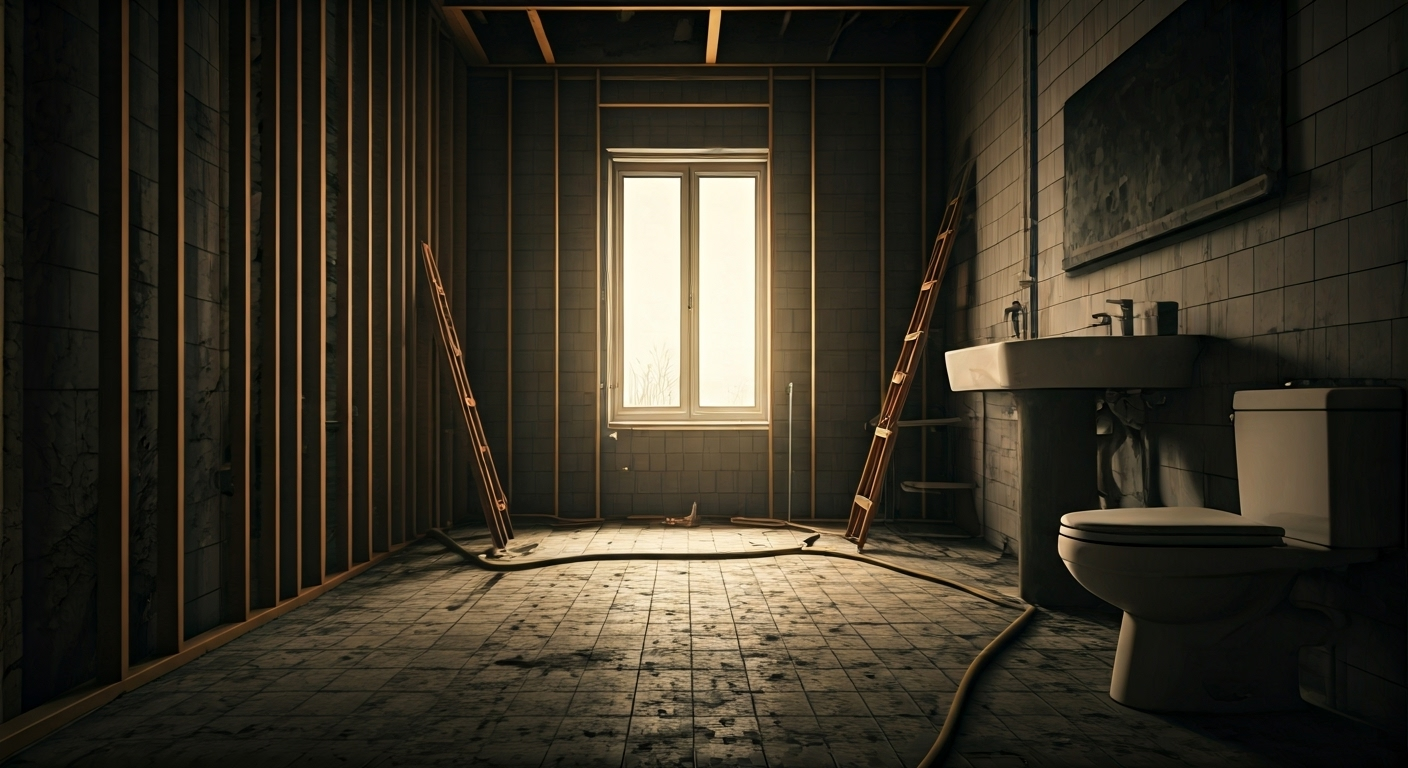
Because this is a big topic on its own, I would suggest that you look over my post, Removing Tile From a Bathroom Wall – The Ultimate Demo Guide. This post will go over all you need to know to demo your old bathroom safely.
However, Step 6 of the next section will go over a few things about preparing for the demo stage.
Tools & Materials
When planning a bathroom remodel as DIY project, you’ll obviously need the right tools and the skills to use them. If you want to know more about the tools and equipment required for your remodel, I am currently writing a post called, DIY Walk In Shower, that goes over all the tools you’ll need and everything else you’ll need to know to build a walk in, or curbless shower.
Preparing for your Remodel, Step by Step
A systematic approach to planning a bathroom remodel is always the best approach. Specifically, you need to measure out your space and enter it all into a design/ layout tool. Then set a timeline and budget that’s realistic, keeping in mind the possible cost of materials and any potential delays. Pick your design and choose the right fixtures/ finishes. If it’s a DIY project, make sure you get all the necessary permits. When all the materials and fixtures show up, get your space ready for demolition. Whether you’re hiring a contractor or you’re doing it yourself, these steps will make the whole project go smoother and faster.
Step 1: Measure the Space & Create a Drawing

Accurate measurements are the foundation of any bathroom remodel. Begin by measuring out your space and entering all your measurements into free online design/ layout tools like Easy Bathrooms or the IKEA Bathroom Planner. Or for more control, and more design features, you can use a paid tool like Smart Draw. Be sure to note windows, doors, and as much plumbing and electrical points as the tool will allow.
Even if you decide to hire an interior designer, this effort will give you a good idea how your favorite fixtures will fit into the space, or if you’ll have to alter your plans somewhat. It will also help prepare you for discussions with your contractor, if you decide to go that route.
When planning a bathroom remodel, you should also be prepared for some layout changes and changes in your chosen list of materials in case things simply don’t fit, or the ergonomics don’t work.
Step 2: Set a Realistic Timeline
Setting up a realistic project timeline is very important when planning a bathroom remodel. Think about the scope of your project and keep in mind the various factors that might slow things down.
Getting all the necessary permits generally takes a lot longer than you think, so be prepared for this by allowing more time than the city/jurisdiction indicates (this estimate is always way off, in my experience).
Also, make sure you have all your fixtures at home and ready for install. This may seem obvious, but it’s a recurring problem in many of my projects because some of my clients believe that certain items are readily available, when they are not.
This oversight always causes unnecessary delays, so an extra effort applied to this helps reduce the chance of delays and helps to reassure your contractor that the project (and the contractor/client relationship) will go smoothly.
Step 3: Finalize Your Design and Select Materials
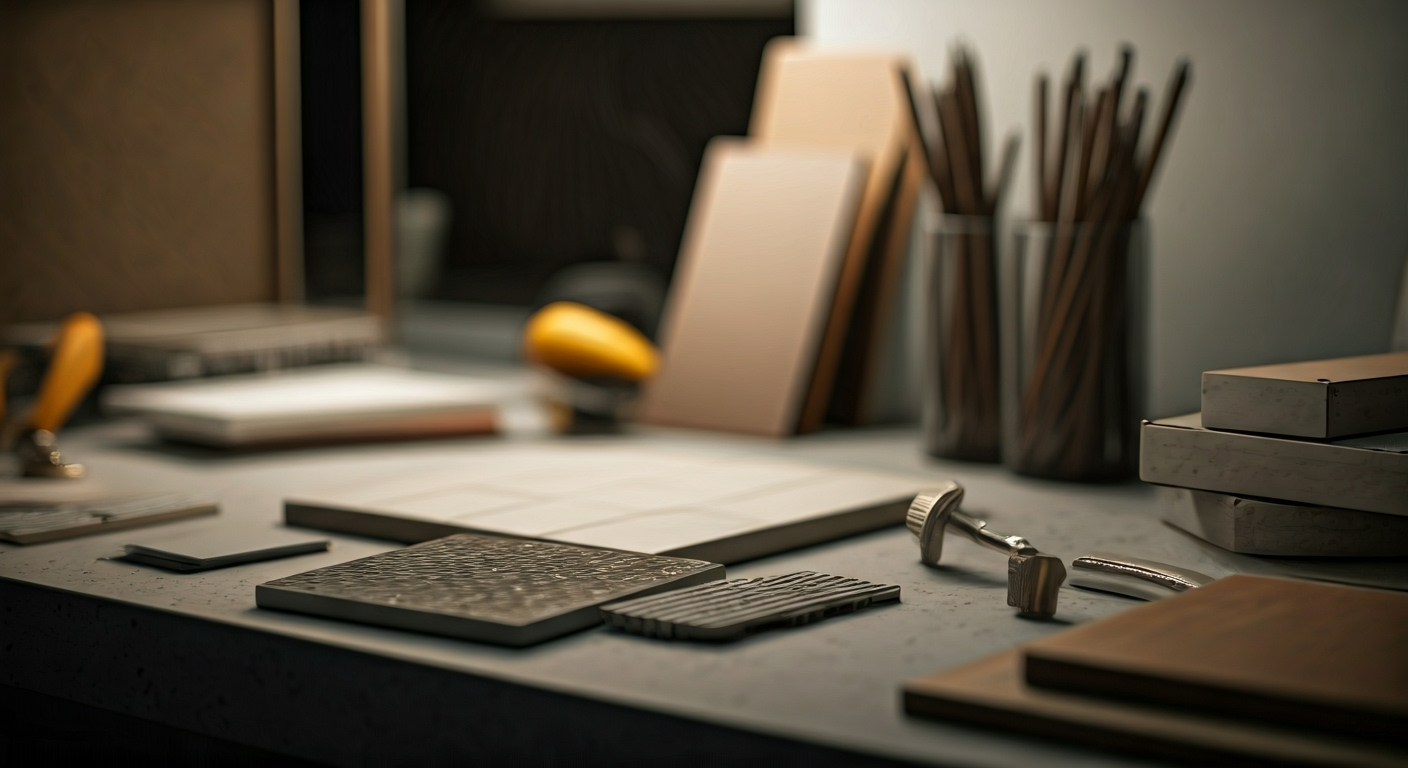
When planning a bathroom remodel, your choice of fixtures and finishes will have a lot to do with your layout, your budget and your design sensibilities. As such, this part of the process works much better with the help of the interior designer.
There are so many things that can go wrong when a homeowner decides on a particular bathroom design from an image on Pinterest and expects their contractor to reproduce it. I have experienced this far too many times. Unless your contractor is as flexible and patient as me, this will cause friction.
You can certainly go ahead and pick out design pics, get samples of tiles, countertops, and paint chips, etc., but you must be flexible. Unfortunately, some bathroom dreams aren’t possible when there are structural, plumbing or electrical limitations in your way.
Step 4: Obtain Necessary Permits
Moving through the steps of planning a bathroom remodel means you have to get all the necessary permits and approvals. Begin by looking into the local building codes surrounding bathroom remodels, because these rules can be different for every jurisdiction. It’s a good idea to talk with your chosen interior designer or contractor, since they can help you with this whole process.
As I mentioned, this process can take an extraordinarily long time. This means that you need to do your research and allot an appropriate amount of time for this, because your project can’t begin without this approval.
I should also mention that I would strongly recommend against beginning any bathroom remodel without permits. MANY of my clients ask me about this because of the expense and delays of obtaining permits.
I always tell them the same thing…you might just get away with doing a remodel without permits, but it will definitely bite you in the *ss if / when you find out that your contractor made a serious mistake, OR you get a property inspection (selling your home), OR if a neighbour happens to complain about renovation noise and the city comes to investigate. In other words, always obtain your permits.
Step 5: Order Fixtures, Tiles, and Other Essentials
As I mentioned before, ordering bathroom fixtures, tiles, and other important items is a key step in planning a bathroom remodel (The text link above is an Amazon affiliate link. See my affiliate disclosure page for details).
After you get some ideas from online resources like Pinterest, tile shops, bathroom suppliers, etc, I would recommend that you get an interior designer involved. This is not absolutely essential, but everything will work out better, easier and less stressful if you hire one…believe me! As I also mentioned, you should be aware that some things might take longer to arrive, so watch for lead times.
Step 6: Prepare the Space for Demolition
When planning a bathroom remodel, making sure your renovation project goes well always starts with demolition. As I mentioned earlier, this is a big enough topic to require it’s own post, so I wrote one: Removing Tile From a Bathroom Wall – The Ultimate Demo Guide. Check it out if you want to “get into the weeds” on this topic but below are some important tips.
A bathroom demo is a very messy, dusty and relatively dangerous process, so I would strongly recommend that you hire a local demo company to do this for you. I always recommend this to my clients and all my diy blog readers because demolitions are unpredictable and dangerous, if you don’t have experience with them.
I also recommend that you organize the proper ventilation for the demo. This is super important to keep particulates from spreading through your home, especially if there are children or elderly living there. This topic is also covered in my bathroom demolition post (see link above).
Step 7: Coordinate with Contractors and Begin Work
The final step of planning a bathroom remodel is getting started on the project. If you are planning to hire a general contractor, my best advice is to communicate regularly with them. And if you have any concerns or even simple (or stupid) questions, just ask them. As the saying goes, there is no such thing as too many questions, especially when it comes to a remodel.
If you’re planning to DIY, I applaud you and encourage you to commit, be flexible, relax, and enjoy the process. Also… don’t put too much pressure on yourself, do things carefully and methodically, and I guarantee that you will feel awesome when you are done. A bathroom remodel of any size can be a super rewarding experience.
FAQ
What is the average cost of a bathroom remodel in the U.S.?
The cost for a bathroom remodel in the U.S. can be anywhere from $10,000 to $25,000. The price depends on the size of the bathroom, the materials you pick, and the cost of local work. If you want a high-end remodel, the price can go much higher than this range. It is important to set your budget early when you’re planning a bathroom remodel.
How long does a typical bathroom remodel take?
A bathroom remodel usually takes about 3 to 8 weeks, depending on the size of the bathroom space and scope of work. Issues like the contractor’s schedule, your design choices, required upgrades (ex: new water lines), or structural problems, can also add to the project timeline.
Should I hire a professional for my bathroom remodel or can I DIY?
Choosing to hire a professional or doing it yourself depends on a few things. You need evaluate your skills, your motivation, your budget, and how much time you have to apply to the project. If you’re not sure about any part of it, ask a professional for help.
What upgrades offer the best return on investment?
Bathroom improvements that usually give you the best return for your money are not usually the “behind the scenes” upgrades like adding energy-efficient windows or installing new insulation. If you’re planning to sell your home, you’d best focus on improving the look and feel of the bathroom. The easiest is a new coat of paint or wallpaper, but more expensive upgrades can include natural stone countertop, new bathroom fixtures and/or new trims, or new vanity drawer and door fronts.
How do I know if I need a plumbing upgrade?
Plumbing upgrades are very common if your home is over 10-15 years old. Old copper water lines are vulnerable to fractures and pin hole leaks after 10 years, so replacing them with WIRSBO pex piping is a great idea when you’ve got all the walls open and accessible. Drainage lines also need to be assessed for leaks but generally have a much longer service life than water lines. This means that they are generally OK if there aren’t any visible leaks.
